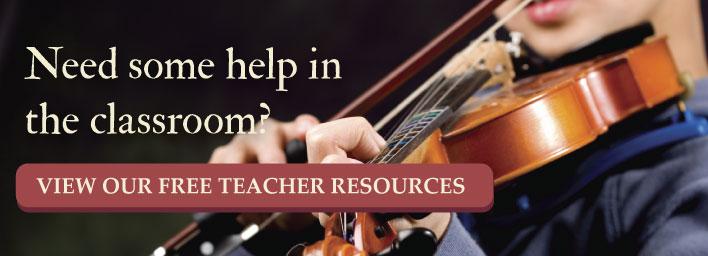Teachers' Corner: Tips for Teaching Unmusical Students

Almost every teacher has been blessed with a gifted student during their career. Learners who display a propensity to grasp rhythm, pitch, and other musical elements immediately are a delight to instruct. Of course, not every pupil has natural talent, however most of them make progress in a fairly similar time frame. Although each student develops at their own unique rate, you can typically measure advancement by curriculum standards.
Some students really struggle with playing a string instrument. This can happen for a variety of reasons. Perhaps that child’s parents know about the cognitive benefits of learning music and are pushing advancement aggressively, generating the opposite result. Maybe there are personal desires involved that are unknown to you. Regardless of the reason, knowing how to break through to unresponsive learners is one of the challenges music educators face.
The following tips can help you teach “unmusical” students how to grasp—what can almost seem as unattainable—musical concepts.
#1. Understand the root cause of the problem
As you know, just because a student is having a hard time performing and understanding music, doesn’t necessarily mean that the person is “unmusical.” Looking for the root of the issue first can help you address it or work around it. For example, does the student really want to play that particular instrument? You may discover that someone who’s having difficulty with violin really wants to play the clarinet or cello. The lack of desire about a particular instrument can lead to less than satisfactory achievement.
Likewise, the student might not want to play. Many parents are only interested in accomplishments and push students into unwanted lessons. While at home, the student doesn’t practice deliberately or practice at all, so their progress is stifled. In either case, maybe that particular instrument isn’t right for the student. By identifying the reason for the failure, you can determine whether it can be overcome.
#2. Tone deaf myth
With students who really apply themselves but still have problems recognizing accurate pitch, this is a major challenge. Many experts don’t believe in tone deafness, and rightly so. However, there’s no denying the fact that some students, even after years of instruction, still struggle with accurate intonation. When learning a bowed string instrument, that’s a serious drawback.
Many times, students have been told that they have no pitch ability. That establishes a mental block. Students must understand that if they can converse, they can recognize tone. Once they understand that they can develop their music sense, you can provide resources that will help them gain it. Perhaps the student would benefit from alternative techniques that concentrate on voice rather than their instrument, or greater improvisation opportunities.
#3. Change the way you interact with the student
Since no two learners respond to the same methods, if you have a student who shows genuine interest but can’t seem to get past certain milestones, you may want to change the way you interpret and interact with them. Eric Booth, author of The Music Teaching Artist’s Bible says that “Eighty percent of what we teach is who we are.” Recognizing and altering your own influence so that it supports a particular student will help you both achieve success.
For example, if the student is playing a piece and you stop them to explain a problem, the student will try again, but now his focus will be on the foreboding issue, rather than the music. Essentially, the problem becomes the lesson. In this case, you may need to ignore some mistakes and just focus on the things that were done correctly. The student will gain confidence, which can go a long way toward achievement.
#4. Keep your cool
Once in a while, you may be tempted to advise a student to give up. If you’ve understood the root problem and it really is insurmountable, it may be best to suggest a break or another instrument. However, if the student shows sincere dedication, keep at it. Perseverance is a virtue for you both, and it may just be an instance where real skill takes an extra-long time to develop.
Although not everyone is gifted with musical talent, learning to create or participate in music isn’t beyond anyone’s capability. The route may be a long and difficult one, but for students who really want to succeed, it is possible. As an educator, your job is to show them how to increase their musical awareness and offer tools that will support their growth. That’s the reason you became an instructor.
If teaching an unmusical student takes more effort and determination on both your parts, understand that the rewards will be that much sweeter when your student finally realizes their goal.


